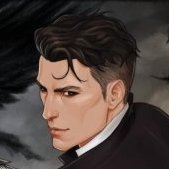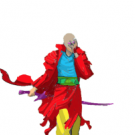-
Posts
1141 -
Joined
-
Last visited
-
Days Won
2
Ripheus23's Achievements
988
Reputation
Single Status Update
-
Monster theory and Apollyon
According to the game-theoretic architecture of the multiverse and the divine realm, some lifeforms are physically possible as a relatively direct computation of the existential manifold of the possible economic sequences. That is, monsters are just beings computed into existence not due to the principle of original obligation (that is, deontic logic contains a theorem of particular duty, which requires that there always exist some agent or agents who are able to satisfy the duty) but due to the helping and harming theorems. Monsters therefore have roughly the following range of dispositions:
- Willing to heal others (H1).
- Can be provoked but otherwise helpful or neutral. (N1)
- Intermittently self-provoked; sometimes docile, sometimes feral, possibly with no discernible order to the exchanges (N2).
- Permanently hostile. (H2)
For example, all unicorns fall into (H1). Though technically all monsters have some form of free will, its physical manifestations are much more limited in range than for regular agents. Monsters are in a real way "game pieces" in the divine plenum of the world. This is why they are so significant throughout:
Now, the major distinction in monster theory is between monsters and supermonsters. The technical distinction is not between two absolutely weaker or stronger monster classes/types, since any monster can perform a maximum move in the Game (relative to its type), and all maximum moves are of equal deontic value simpliciter. Or, rather, internal to the H/N categories this is so. To illustrate, therefore, the idea is that the supermonsters are just those that can (A) perform a greater number of moves in general and (B) perform a greater number of maximum moves. So there is an abstract higher chance for a supermonster to perform a maximum move, at any given interval, than there is for a normal monster to do so.
It is common for people to think of the demiplane of Apollyon as a sort of supermonster. However, in the theory of the monster transet, this is not exactly so: Apollyon is referenced as the antimonster or the "empty monster" (on the analogy with the "empty note" soundex for the glyph of Apollyon*). Nevertheless...
As noted, besides Damnite and Armirex, five other Noumenal Artificers are counted as having Fallen. One of these did so in the early age of the multiverse, three more over various ensuing ages, and the fifth near the halfway mark between the day of genesis and the days of ascension. The first of these did so alongside the only three Fallen Metroarchs (so to speak) in history. The mistake that these agents made was this: in a mysterious assault on the demiplane of Apollyon, they attempted to divide the ecographic manifold of Apollyon's monster-theoretic identity into six pieces, one for each chord in the Song of Destruction. This succeeded in bringing about the Dirge-shadows, and after learning of what they had wrought, the four Fallen ones killed themselves in horror.
Just as the Form of Evil's crystal shadow in the physical world was used to contain the seraph hydra (the monster of the crystal), so was it used as part of the seal on Apollyon's power. Namely, if you represented the multiverse as a gameboard of some kind, then the location of the Veldaithemyr (the city that is the size of one entire of the 24 universes) is the location where the monster-gamepiece of the Destroyer is indexed (overlapped). And the idea is that this is a monster that can be "awakened" by an unwary "player"... But that stasis-in-waiting was imposed on Apollyon in part using the Form of Evil's own power to seal monsters. (Another major component was, of course, the rift in Cantor's staircase; but this too was entangled with the ancient darkness.)
When Apollyon awakens from the Veldaithemyr, therefore, it transforms the manifold of that city, part by part, into an icon incarnate of its (the Destroyer's) reality. It refashions the skyscrapers surrounding its heart into buildings equipped with massive weapons systems of various forms: missile arrays, lasers, energy-bolts, etc. all insomuch as these systems are implicit reflections of possible sinstone weapons systems.*** Because it has an "external" image for itself already (the city on the floating Mountain of Slaughter), it can manifest through the finitude (the Veldaithemyr is in one of the finite-size universes) of its surroundings without violating its infinite power.
[*In addition to a chromatic index, it is possible for an aleph-glyph to have a sound index or soundex (AKA an index of tonality). This is represented as a sound that is to be played whenever a soundexed glyph is especially displayed. In regions where electronic sound systems have yet to be developed, mathematicians who wish to indicate the range of specific indices of tonality usually carry with them an instrument known as an orchestrium, which is a sort of agglomerate of other kinds of musical instruments, reduced from their typical size to fit the scale of the orchestrium (as a handheld piece). Although not every transet has a soundex, Apollyon's aleph-number specifically has the soundex of silence itself (think of it like: the difference between not having a .wav file assigned to play when you click on the glyph, and having an empty .wav file assigned to play when you click on the glyph).
[***Not only did the Last War commence owing to the use of the Sin-gem, but many of the hostilities commenced and proceeded according to the development of a large number of sincrystal weapons systems. For example, the energy released from broken sinstones [the brick-shaped Dirge-shadow pieces] could be focused through a hosotopic lens (a spheration yielded by the special controlled action of a hosotopic wave) to form an extremely destructive kind of laser-like ray. Nevertheless, (most of?) the major factions using these weapons did not believe themselves to be servants of Apollyon, but professed that they were in some way trying to use Apollyon's own power to defeat the antimonster.]
Apollyon's argument
Inasmuch as the endgame of the story is a personal confrontation between Ripheus and Apollyon, what is the argument of the Destroyer in the end of days? One point that the Form of Destruction makes is that although Ripheus could use the Final Power to destroy that very Form, the City of Destruction in its totality is made of sincrystal, which means that breaking the entire City would unleash the ultimate nova of sincrystal power possible, one sufficient to annihilate all contingent reality in a flash. [This is more extreme than it sounds: the concept of the exchange specifically concerns the distinction between necessity and contingency, and the relationship between these concepts and the concept of free will---which in turn has implications for the ecology of moral logic at work overall, here. Think of how Armirex tries to interpose the Forms of Evil and Nothingness. Apollyon itself intends to interpose the Forms of Necessity and Contingency, so to say.] So, since Apollyon has no concept of what else Ripheus could do to halt the damnation of the cosmos, the Destroyer tries to convince Ripheus to let go of the Shield, commands the man to do so in fact. [However, Ripheus does not intend to kill Apollyon at all, anyway.]
-
Since priority problems in abstract ethics underwrite the matter of the world, and since it is through sigma-actuation that the Trinity transcreates the world, it follows that the corruption of the order of modality is the ultimate act of divine evil that Apollyon is capable of. That is,
[Apollyon is killed and the world explodes OR Apollyon transcreates all possible sin at once OR Apollyon corrupts the distinction between necessity and contingency and violates the power of transcreation in general]
So, as long as it can achieve one of these goals, Apollyon will be satisfied with the outcome of eternity, so to speak, and it is against this tripartite goal that Ripheus must take his stand in the end.
-
Or it could be that transcreating all possible sin at once is equivalent to violating the order of modality in itself. That sounds like a more philosophically analyzed description of the problem (danger) inasmuch as the violation of free will in the uncreated sin's light, would amount to an inversion of necessity and contingency inside of free will itself already?
-
OR, rather, the necessity/possibility/contingency corruption appends to either of the other two purposes?
RE: unicorns:
Forgot to mention: although it is possible to use magic to resurrect people from the dead,* and although unicorns have healing magic, it is usually not possible for unicorns to resurrect people. However, during the Battle of el Samir, the metroarchic equine, the ecoarchic ur-unicorn, and the occurrent auroch unicorn, combined their powers to resurrect one of the members of the team** sent to fight the Form of Evil.
*[The idea is that sometimes people deserve to be resurrected. The deduction is based on my theory of the Resurrection of Christ, namely that if "ought" implies "can" and if Christ ought to have been resurrected, then He could have been (and apparently was). Magically, this amounts to the Artificers (for the primary example) being able to raise people from the dead using the moral energy of the economies.]
**[The Meretzky strategy, AKA the eagle gambit, is the deployment of a small number of spellcasters to fight a major enemy, according to the idea that the smaller number of personnel is less likely to draw the enemy's attention. It is named in honor of the sorcerer-educator Stefan Meretzky [although technically he did not, IRL, author the game Enchanter] and the theory of why the Eagles were not used in the quest to destroy the Ring of Sin in the Land of Murder [if you know what I mean...].]




